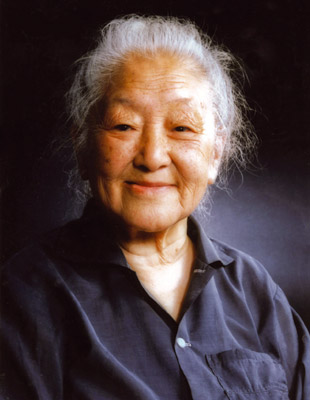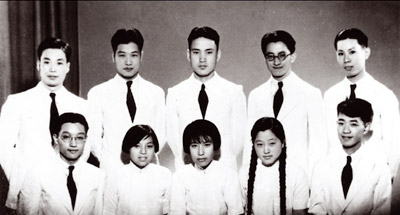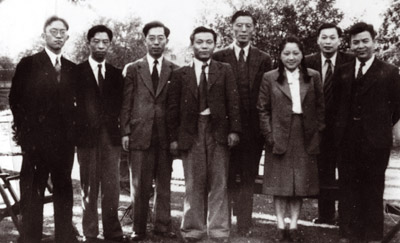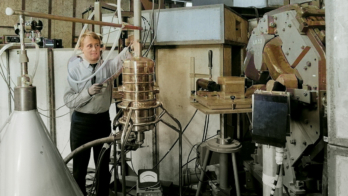The life and times of a pioneering Chinese physicist.

Image credit: Jian-she Zhang.
This year marks the 100th anniversary of the first International Women’s Day and, appropriately, the awarding in December 1911 of a second Nobel prize to Marie Curie. No other woman physicist has achieved such worldwide acclaim, and although there have been a number of high-flyers they remain relatively unknown. One such person is Zehui He (Zah-Wei Ho), who worked at the Curie Institute in Paris in the 1940s before becoming a leading figure in nuclear physics in her own country of China.
Zehui was born in 1914 in Suzhou, on the lower reaches of the Yangtze River, into a family of eight children where culture and learning were as important for the girls as for the boys. After studying at a school for girls (which had been established by her maternal grandmother) and succeeding in a national competition, she was admitted to the physics department of the Tsinghua University, Peking (now Beijing), in 1932. In a class of 28 there were 10 women, and the head of the department strongly discouraged all of them from pursuing a career in physics, a common habit at the time (not only in China). However, he did not succeed with Zehui, and she came out top of the 10 students – including two other women – who graduated in 1936.
Some of the professors, Zehui later recalled, did appreciate her talent and pushed her towards a stimulating final research project on “A voltage stabilizer of electric current used in laboratories”. Yet, afterwards, like the other female graduates she was offered no support when looking for somewhere to continue her studies or to work. It was thanks again to her persistence, as well as to a fund granted by her native Shanxi Province, that she was able to go to Germany to pursue a doctoral degree at the Technical Physics Department of the Technische Hochschule in Berlin. Sanqiang Qian (San-Tsiang Tsien), who was also at the top of Zehui’s class in 1936, after working in the institute of physics in Peking for a year, went to Paris in 1937 to the laboratory of Irène Curie (Marie’s daughter) and her husband Frédéric Joliot. He obtained his doctorate there in 1940 with a thesis on “Étude des collisions des particules α avec les noyaux d’hydrogène” supervised by the Joliot-Curies.

Image credit: Qian family.
In Berlin, meanwhile, Zehui pursued a doctorate in experimental ballistics with a thesis on “A new precise and simple method of measuring the speed of flying bullets”. By then it was 1940 and the Second World War had begun. Zehui was stuck in Germany, but she found work in Berlin with the Siemens Company and did research on magnetic materials from 1940 to 1942. However, during her studies Zehui had stayed at the home of Friedrich Paschen, well known for spectroscopy and the eponymous hydrogen series and line-splitting in a strong magnetic field. The Paschen family loved Zehui as one of their own, and Paschen introduced her to his friend Walther Bothe, director of the Physics Institute of the Kaiser Wilhelm Institute for Medical Research in Heidelberg. There, Zehui converted to basic research in nuclear physics.
Given the time (1943) and the place (soon to be not far from the war’s front line), it was an improbable scenario. Bothe, one of the principals of the German Uranium Project, had returned to basic research in Heidelberg, where in December 1943 the 10 MeV cyclotron came into operation – the first in Germany. While Bothe used counters and electronics to study cosmic rays and radioactive nuclei, his colleague Heinz Maier-Leibnitz built a cloud chamber and, together with Bothe and Wolfgang Gentner, in 1940 published the Atlas of Typical Cloud Chamber Images – a reference for identifying scattered particles.
Zehui worked with Maier-Leibnitz on building a second cloud chamber to study positron–electron collisions, using positrons from the decays of artificially produced radioactive isotopes, with a view to checking the validity of Homi Bhabha’s and Bothe’s calculations based on Paul Dirac’s theory. The advantage with respect to electron–electron elastic collisions was the lack of ambiguity between recoil and scattered particles, allowing a separation between events of large and small energy-exchange. The experiment, which used positrons from a source of 52Mn, also allowed a cross-check of Hans Bethe’s calculation of the ratio of annihilation to elastic cross-sections.
Breakthrough
The first ever picture of a positron–electron scatter was shown at the cosmic-ray conference in Bristol in September 1945 and mentioned in a report on the meeting published in November (Nature 1945). In all, Zehui measured 178 elastic collisions from 2774 positrons and found that: “In the first approximation, there is a general agreement between the theoretical and the experimental curves [for the number of collisions]. But it seems that in the case of strong energy exchange (A> 0.6), for which the measurements are more precise, the experimental values are higher than the theoretical ones” (Ho 1947). She also observed three annihilation events, as expected from Bethe’s calculations.
The results were widely disseminated. On 5 April 1946, a paper on the measurements was read by R W Pohl in Gottingen, then on 15 April by Joliot in Paris. In July 1946, Sanqiang Qian presented the work at the International Conference on Fundamental Particles and Low Temperatures in Cambridge; and a letter, sent at around the same time to Physical Review, was published in August that year (Ho 1946).
Sanqiang and Zehui proved the existence of ternary fission from the measurement of fission traces
Meanwhile, Zehui had moved from Heidelberg to Paris, where she rejoined her classmate Sanqiang, marrying him in the spring of 1946. From 1946 to 1948 she worked at the Nuclear Chemistry Laboratory of Collège de France and the Curie Laboratory of the Institut du Radium. Continuing the research she had started in Germany and using a cloud chamber with a long time sensitivity, as developed by Joliot, Zehui measured the spectrum of positrons and gammas from the decays of 34Cl and 18F, and also confirmed her previous result on positron–electron collisions. However, the discrepancy with the theory at large-energy transfer was not observed by others.

Image credit: Qian family.
Working with Sanqiang and two PhD students – R Chastel and L Vigneron – Zehui went on to study the fission processes induced by slow neutrons, using nuclear emulsions loaded with uranium. After the discovery of fission in 1938 it was generally believed that the nucleus of a heavy atom splits into two lighter nuclei. However, with these experiments Sanqiang and Zehui proved the existence of ternary fission from the measurement of fission traces; they also explained the mechanism of such a reaction and predicted the mass spectrum of the fragments (Tsien et al. 1947). Zehui also made the first observation of quaternary fission in November 1946. Ternary fission was not understood by the physics community until the late 1960s, and multifission not verified until the 1970s.
In May 1948 Zehui returned to China with her husband and their six-month-old daughter. (A second daughter was born in 1949 and a son in 1951.) The couple’s involvement in science became deeply intertwined with the history of their country, echoing the farewell advice of the Joliot-Curies that they should “serve science, but science must serve the people”.
Zehui was immediately recruited as the only full-time research fellow in the Atomic Research Institute of the National Peking Research Academy. After the founding of the People’s Republic of China in 1949 she became a research fellow (1950–1958) at the Modern Physics Institute of the Chinese Academy of Sciences (CAS) and then research fellow (1958–1973) and deputy director (1963–1973) of the Atomic Energy Institute. Following the establishment of the Institute of High-Energy Physics (IHEP) at the CAS in 1973, she moved there as a research fellow and deputy director (1973–1984). She was elected a member of the academy in the Mathematics and Physics Division in 1980 and was also a standing member of the Chinese Space-Science Society.
Focusing on nuclear research
In all of her administrative positions, Zehui’s constant preoccupation was to develop her country’s nuclear research, almost from scratch to the current achievements. In 1956, for example, her group succeeded in making nuclear emulsions of a quality comparable to the most advanced in the world, mainly with respect to the ones sensitive to protons, alpha particles and fission fragments.
An important change took place in 1955 when the Chinese government decided to move into nuclear energy. Sanqiang took on major responsibilities in setting up a nuclear industry and by 1958, with help from the Soviet Union, the first Chinese nuclear reactor and a cyclotron had started operation. Zehui led the Neutron Physics Research Division of the Modern Physics Institute (later renamed Atomic Energy Institute) and made important contributions to the establishment of basic laboratory infrastructure, the design and manufacture of measuring instruments, and the development of various types of equipment.
Around 1966, Zehui disappeared from public view as a result of the Cultural Revolution. This was over by 1978, when for the first time in more than 30 years she visited Germany as a member of a government delegation. Around the same time, Sanqiang led a Chinese delegation to visit CERN – where the Super Proton Synchrotron had recently become operational – and later to the US and many other countries, working hard to promote international scientific collaboration.

Image credit: Qian family.
In the wake of that effort, the Beijing Electron–Positron Collider was initiated, achieving its first collisions on 16 October 1988. Meanwhile, Zehui, in charge of the Cosmic Ray and Astrophysics Division of IHEP, promoted research in these fields. Under her initiation and fostering, the former cosmic-ray research division of IHEP built – through domestic and international collaborations – nuclear emulsion chambers installed at the highest altitude in the world (5500 m) on Kam-Pala mountain in Tibet. Also, starting from scratch, the division launched scientific balloons of increasing size near Beijing. In parallel, following the launch of the first Chinese satellite in 1970, the technology was developed to detect hard X-rays in space. As before, under Zehui’s direction and influence, generations of young researchers rapidly grew up to become the key figures in nuclear and space science in China.
Zehui He died in June 2011, nearly 20 years after Sanqiang Qian (1913–1992). She had continued to work full time until late in life, maintaining the high standards that she had always cherished. She loved her country and science; to both she is now an icon.





